Notes
- ↑ Addison, Remarks on Several Parts of Italy, &c: in the years 1701, 1702, 1703.
- ↑ For example, Hesiod, Catalogue of Women fr. 27 and Apollonius, Argonautica 4.892–4.
According to the Roman poets Virgil ( Aeneid , 5.864) and Ovid, the Sirenum scopuli were three small rocky islands where the sirens of Greek mythology lived and lured sailors to their deaths. "The Sirenum Scopuli are sharp rocks that stand about a stone's throw from the south side of the island" of Capri, was Joseph Addison's confident identification. [1]
Diverse locations were assigned to the isles of the sirens by various authorities. According to Homer's Odyssey , they were between Aeaea and the rock of Scylla. Often they have been placed in the Tyrrhenian Sea, off the coast of south-western Italy near Paestum or between Sorrento and Capri: "three small islands on the southwest coast of Campania, now Licosa, St. Pietro and La Galetta" reported George Richard Crooks, Christian Frederik Ingersley, on the basis of Alexander Jacob Schem, A New Latin-English School-Lexicon, (Philadelphia), 1861 s.v. "Siren".
Similarly, Anthemoessa (or Anthemusa) was the island home of the sirens in other versions of the myth. [2] Although the name no longer exists, varying accounts attribute Anthemoessa to the island of Ischia or Capri in the Gulf of Naples.
Further traditions place the sirens on Capo Peloro or the Sirenuse islands near Paestum.
All locations were described to be surrounded by cliffs and rocks.

Jason was an ancient Greek mythological hero and leader of the Argonauts, whose quest for the Golden Fleece featured in Greek literature. He was the son of Aeson, the rightful king of Iolcos. He was married to the sorceress Medea. He was also the great-grandson of the messenger god Hermes, through his mother's side.
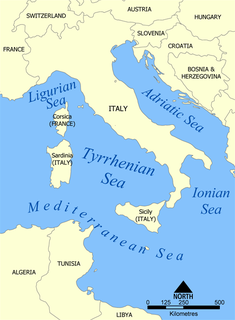
The Tyrrhenian Sea is part of the Mediterranean Sea off the western coast of Italy. It is named for the Tyrrhenian people identified with the Etruscans of Italy.
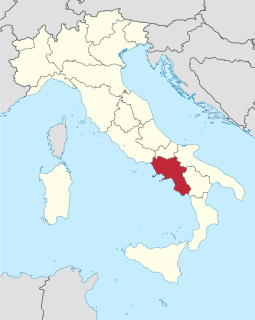
Campania is an administrative region of Italy; most of it is in the south-western portion of the Italian peninsula, but it also includes the small Phlegraean Islands and the island of Capri. The capital of the Campania region is Naples. As of 2018, the region had a population of around 5,820,000 people, making it Italy's third most populous region, and, with an area of 13,590 km2 (5,247 sq mi), its most densely populated region. Based on its GDP, Campania is also the most economically productive region in southern Italy and the 7th most productive in the whole country. Naples' urban area, which is in Campania, is the seventh most populous in the European Union. The region is home to 10 of the 58 UNESCO sites in Italy, including Pompeii and Herculaneum, the Royal Palace of Caserta, the Amalfi Coast and the Historic Centre of Naples. In addition, Campania's Mount Vesuvius is part of the UNESCO World Network of Biosphere Reserves.
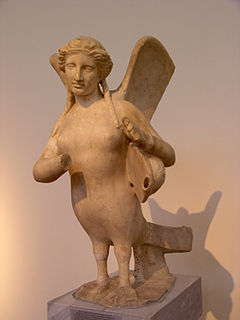
In Greek mythology, the sirens were dangerous creatures, who lured nearby sailors with their enchanting music and singing voices to shipwreck on the rocky coast of their island. It is also said that they can even charm the winds. Roman poets placed them on some small islands called Sirenum scopuli. In some later, rationalized traditions, the literal geography of the "flowery" island of Anthemoessa, or Anthemusa, is fixed: sometimes on Cape Pelorum and at others in the islands known as the Sirenuse, near Paestum, or in Capreae. All such locations were surrounded by cliffs and rocks.
In Greek mythology, the Planctae or Wandering Rocks were a group of rocks, between which the sea was mercilessly violent. The Argo was the only ship to navigate them successfully. Jason chose to brave the Planctae instead of braving Scylla and Charybdis.

Ustica is a small Italian island in the Tyrrhenian Sea. It is about 5 kilometres (3 mi) across and is situated 52 kilometres (32 mi) north of Capo Gallo, Sicily. Roughly 1,300 people live in the comune (municipality) of the same name. There is a regular ferry service from the island to Palermo in Sicily.
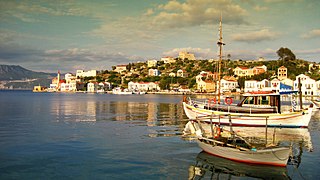
Kastellorizo or Castellorizo, officially Megisti, is a Greek island and municipality of the Dodecanese in the Eastern Mediterranean. It lies roughly 2 kilometres off the south coast of Turkey, about 570 km (354 mi) southeast of Athens and 125 km (78 mi) east of Rhodes, almost halfway between Rhodes and Antalya, and 280 km (170 mi) northwest of Cyprus. Kastellorizo is part of the Rhodes regional unit.

Capri is an island located in the Tyrrhenian Sea off the Sorrento Peninsula, on the south side of the Gulf of Naples in the Campania region of Italy. The main town Capri that is located on the island shares the name. It has been a resort since the time of the Roman Republic.

Positano is a village and comune on the Amalfi Coast, in Campania, Italy, mainly in an enclave in the hills leading down to the coast.

Sazan is an uninhabited island in the Mediterranean Sea, and is part of southern Albania. The largest of Albania's islands, it is a designated military exclusion zone; it lies in a strategically important location between the Strait of Otranto and the mouth of the Bay of Vlorë, marking the border between the Adriatic and Ionian seas. The island has a surface area of 5.7 km2 (2.2 sq mi). It is 4.8 km (3.0 mi) long and 2 km (1.2 mi) wide, and its coastline measures about 15 km (9.3 mi).
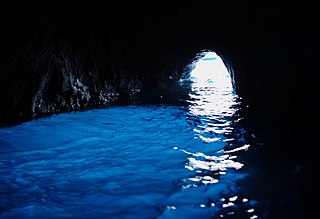
The Blue Grotto is a sea cave on the coast of the island of Capri, southern Italy. Sunlight passing through an underwater cavity and shining through the seawater creates a blue reflection that illuminates the cavern. The cave extends some 50 metres into the cliff at the surface, and is about 150 metres (490 ft) deep, with a sandy bottom.

Aeaea, Ææa or Eëä was a mythological island said to be the home of the goddess-sorceress Circe. In Homer's Odyssey, Odysseus tells Alcinous that he stayed here for one year on his way home to Ithaca. He says that he could not resist the need to be on this island, not so much for Circe but so that he does not resist the pull. The modern Greek scholar Ioannis Kakridis insists that any attempt at realistic identification is in vain, arguing that Homer vaguely located Aeaea somewhere in the eastern part of his world, perhaps near Colchis, since Circe was the sister of Aeëtes, king of Colchis, and because their paternal aunt the goddess Eos had her palace there.

Ponza is the largest island of the Italian Pontine Islands archipelago, located 33 km (21 mi) south of Cape Circeo in the Tyrrhenian Sea. It is also the name of the commune of the island, a part of the province of Latina in the Lazio region.

George Norman Douglas was a British writer, now best known for his 1917 novel South Wind. His travel books, such as Old Calabria (1915), were also appreciated for the quality of their writing.

Paestum was a major ancient Greek city on the coast of the Tyrrhenian Sea in Magna Graecia. The ruins of Paestum are famous for their three ancient Greek temples in the Doric order, dating from about 550 to 450 BC, which are in an excellent state of preservation. The city walls and amphitheatre are largely intact, and the bottom of the walls of many other structures remain, as well as paved roads. The site is open to the public, and there is a modern national museum within it, which also contains the finds from the associated Greek site of Foce del Sele.

Terra Sirenum is a large region in the southern hemisphere of the planet Mars. It is centered at 39.7°S 150°W and covers 3900 km at its broadest extent. It covers latitudes 10 to 70 South and longitudes 110 to 180 W. Terra Sirenum is an upland area notable for massive cratering including the large Newton Crater. Terra Sirenum is in the Phaethontis quadrangle and the Memnonia quadrangle of Mars. A low area in Terra Sirenum is believed to have once held a lake that eventually drained through Ma'adim Vallis.

Events in the main sequence of the Odyssey take place in the Peloponnese and in what are now called the Ionian Islands. Incidental mentions of Troy and its house, Phoenicia, Egypt, and Crete hint at geographical knowledge equal to, or perhaps slightly more extensive than that of the Iliad. However, scholars both ancient and modern are divided as to whether or not any of the places visited by Odysseus were real.

The Sirenusas, also known as the Gallos, are an archipelago of little islands off the Amalfi Coast of Italy between Isle of Capri and 6 km (4 mi) southwest of Province of Salerno's Positano, to which it is administratively attached. They are part of the Campanian Archipelago. The name, Sirenuse, is a reference to the mythological sirens said to have lived there.

Marina Grande is the main port of the island of Capri in Italy, to the north of the main town of Capri and at the foot of Mount Solaro.
Santa Maria del Soccorso is a church located within the archaeological site of Villa Jovis, on the island of Capri, Italy. It is situated on the summit of the Lo Capo hill at the eastern extremity of the island. The chapel-like church, was constructed ca. 1610. Its fittings include a bronze statue of the Madonna, a 1979 gift of the Caprese painter Guido Odierna (1913-1991). In the late 19th century, hermit lived at the church, keeping a visitor's book and selling wine.